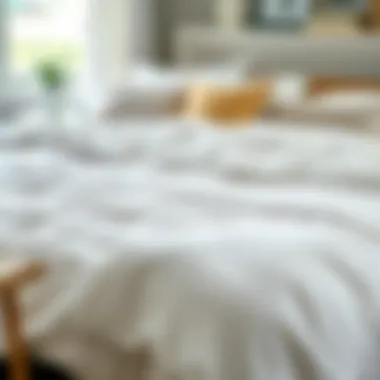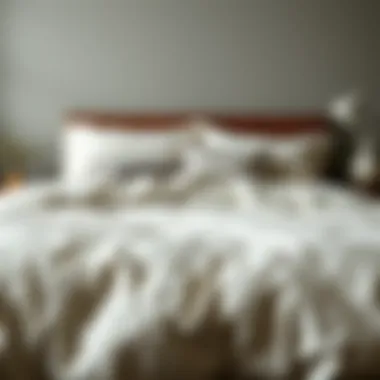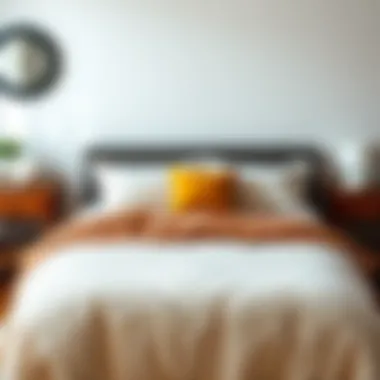A Complete Buyer’s Guide to Quality Duvet Covers


Intro
When it comes to crafting the perfect bedroom, the importance of bedding cannot be overstated. A duvet cover is not merely an aesthetic choice; it's the unsung hero of comfort and style in your sanctuary. As homeowners, interior designers, and decorators embark on the quest to enhance their spaces, it is crucial to understand the nuances of quality duvet covers. This guide aims to navigate through these complexities, shedding light on how to make informed decisions that blend both form and function.
Quality duvet covers offer a touch of luxury, elevate the overall look of a room, and provide much-needed coziness at the end of a long day. With a plethora of options available on the market, from fabric types to designs, finding the right duvet cover can feel like searching for a needle in a haystack. Throughout this article, we'll explore the factors that play into the selection process, including materials, sizing, and pricing.
Get ready to dive deep into the world of duvet covers, where thoughtful design meets practical choice, and where your bedding dream can come to life.
Understanding Duvet Covers
When diving into the realm of bedding, duvet covers often slip under the radar. Yet, understanding them can tremendously influence your comfort and aesthetic appeal of your bedroom. A good duvet cover does more than just serve a functional purpose; it shapes the entire vibe of your restful space. It’s vital to appreciate their significance. They protect your comforter, provide a soft touch to your skin, and easily change the look of your bedding without having to replace the whole set.
Definition and Purpose
A duvet cover is essentially a protective layer for your duvet or comforter. Unlike a traditional blanket, a duvet is typically filled with down, feathers, wool, or synthetic materials and is pretty much intended for warmth. The duvet cover acts like a pillowcase, encasing the duvet to keep it clean and add an extra layer of style.
Not only do duvet covers come in numerous colors, patterns, and designs, but they also allow for easy maintenance. Simply remove the cover when it needs washing instead of struggling with the whole duvet itself. This means they save time too, especially for busy homeowners juggling life. Also, switching out duvet covers can breathe new life into your room, giving it a fresh look according to the seasons or your mood.
Differences Between Duvet Covers and Comforters
Many people get confused between duvet covers and comforters, thinking they serve the same purpose, but there’s a clear distinction. A comforter is a thick, quilted blanket that typically comes filled and is ready to be used right out of the package. On the flip side, a duvet cover is just that - a cover. While comforters usually have specific designs and patterns stitched into them, duvet covers are more about choosing the aesthetic you want and swapping styles at your leisure.
The practical benefits are also noteworthy: duvet covers are often machine-washable, making them easier to maintain compared to comforters that can be hefty and hard to clean. This makes duvet covers quite favorable for families or anyone wanting to make their bedding upkeep a bit simpler.
Key Features of Quality Duvet Covers
When it comes to selecting a duvet cover, understanding its defining features can greatly influence your overall satisfaction. A duvet cover isn't just a mere decorative piece; it plays a crucial role in protecting your duvet and enhancing your sleep quality. Knowing what to look for can transform your nighttime experience. Let's explore the key features that define quality duvet covers, focusing on fabric types, thread count, and design considerations.
Fabric Quality and Types
Common Fabrics Used
Diving into the fabric choices, a few stand out more than others. Common options include cotton, linen, and polyester. Cotton duvet covers are loved for their softness and breathability. Unlike synthetic materials, cotton helps wick away moisture, making it a popular choice for those who seek comfort through all seasons. Linen, while a bit pricier, offers a unique texture that actually becomes softer with each wash — a true testament to age and quality.
Polyester, on the other hand, is a popular option for its durability and affordability. It resists wrinkles and is easy to clean, appealing to busy homeowners. However, it lacks the breathability of natural fibers, which might make it less comfortable in hotter climates. An astute buyer weighs these characteristics when choosing the best fit for their needs.
Natural versus Synthetic Fibers
When pitting natural against synthetic fibers, different advantages come into play. Natural fibers like cotton and linen are not only biodegradable but also hypoallergenic, making them suitable for sensitive skin. They offer a sustainable solution and communicate a timeless aesthetic. In contrast, synthetic fibers coud offer more color retention and less fading, which might appeal to those looking for vibrant designs.
Yet, it’s crucial to note that while synthetic fibers can be more durable, they often trap heat and moisture, potentially leading to discomfort during the night. Homeowners must consider their climate as well as personal preference when making this choice.
Thread Count Significance
Thread count is often seen as a reliable measure of quality; higher counts tend to suggest a smoother, more luxurious feel. However, it's important to remember that the quality and type of the thread matters just as much. A duvet cover with a thread count between 300 and 500 is commonly viewed as a sweet spot—providing comfort without sacrificing durability. It’s all about balance. Too high a thread count might mean tightly packed threads, which can cause heat retention. Thus, understanding thread count is vital in choosing the right duvet cover.
Design and Aesthetic Considerations
Color Options
Colors can dramatically influence the room's atmosphere. Light, airy tones can promote relaxation, making them ideal for bedrooms. On the flip side, darker hues add drama and depth. Consider how the color aligns with your existing decor. Choosing a hue that complements or contrasts with room accents can elevate your interior design.
A common choice for many is neutral shades since they offer versatility. However, someone who’s more adventurous might prefer bold colors to make a statement. It’s about striking the right balance between what looks good and what feels good.
Patterns and Styles
Moving on to patterns and styles; the choices here are endless. From florals to geometric shapes, patterns can either uplift the mood or create a serene setting. Floral patterns often evoke a sense of calm and connection to nature, whereas geometric styles can give off a modern, sophisticated vibe.
In addition to aesthetics, consider the practicality of pattern and style. For instance, lighter colors might show stains more easily, demanding more care and maintenance. Finding a pattern that aligns with your lifestyle is just as vital as its aesthetic appeal. Here, the tone shifts to discerning needs versus wants — and that can greatly affect the selection process.
"Choosing a duvet cover is not merely a matter of taste; it is about enhancing your sleeping experience through thoughtful selections."


Ultimately, understanding the key features of quality duvet covers allows you to make an informed and fulfilling choice. Focused decisions based on fabric type, thread count, and design ensure that your bedding setup is not just visually appealing but also comfortably practical.
Choosing the Right Size
Selecting the appropriate size for your duvet cover is a critical aspect of enhancing your bedding experience. A well-fitted duvet cover not only uplifts the aesthetic appeal of your bedroom but also contributes to your comfort levels during sleep. When a duvet cover is too large or too small, it can lead to an uncomfortable sleeping environment or an unsightly bed. Thus, understanding how to navigate through this is essential for making a sound choice.
Standard Bedding Dimensions
Different bed sizes come with their own standard dimensions. Familiarity with these measurements can more than simplify the selection process; it can also save you from unnecessary returns. Here are the common bed dimensions:
- Twin: 39 inches x 75 inches
- Full: 54 inches x 75 inches
- Queen: 60 inches x 80 inches
- King: 76 inches x 80 inches
- California King: 72 inches x 84 inches
When shopping for a duvet cover, it’s crucial to factor in these dimensions as they dictate the sizing of the cover you need. Quality duvet covers typically come in standard sizes categorized to match these bedding dimensions.
Fitting a Duvet Cover to Different Bed Sizes
Achieving a proper fit requires more than just knowing the standard sizes. Here are some considerations to keep in mind:
- Duvet Insert Dimensions: Be aware that you’ll want your duvet cover to match the duvet insert. For example, a queen duvet insert should be paired with a queen cover, keeping your duvet snug and in place.
- Blanket Tuck: Think about whether you prefer a tailored look, where the duvet neatly aligns with the edges of the bed, or a more relaxed approach with extra fabric that can be tucked under the mattress. This is often a matter of personal style and functional preference.
- Additional Layering: If you use additional layers, such as throw blankets or decorative quilts, you might want a slightly larger duvet cover to allow for a layered look without exposing the mattress.
- Shrinkage and Fit: Consider the potential shrinkage of materials during washing. Cotton, for example, may shrink slightly after the first wash. Depending on the fabric composition, it's wise to select a cover one size up if you're concerned about a snug fit after washing.
Getting the size right may seem like a trivial task, but it holds significant sway over your overall bedroom ambiance and comfort. By putting thought into this aspect, you're paving the way for a more enjoyable sleeping experience.
A well-fitting duvet cover speaks to the harmony of comfort, aesthetics, and care for your space.
Sourcing Quality Duvet Covers
Finding the right duvet cover is a crucial step in enhancing the comfort and aesthetic of your bedroom. Whether you’re sprucing up a guest room or refreshing your master suite, sourcing quality duvet covers can make a world of difference. Not only do they affect the overall look and feel of the space, but they also play a key role in your sleeping experience. As you browse through options, consider the various sources—from online retailers to physical stores—along with the advantages each offers.
Online Retailers
Shopping for duvet covers online has become a popular choice, reflecting both convenience and access to a vast selection.
Pros and Cons of Online Shopping
Online shopping presents a double-edged sword. One major advantage is the sheer variety of choices available at your fingertips. You can explore countless styles, colors, and materials without ever leaving your couch. There’s also the benefit of comparing prices across multiple platforms, which can save a pretty penny.
However, buying online isn't without its pitfalls. You miss out on the tactile experience of feeling the fabric or observing the true color, which sometimes leads to surprises upon arrival. This aspect—often underappreciated—might be significant when it comes to finding just the right fit for your decor.
- Key Characteristics:
- Disadvantages:
- Convenience: Shop any time you want.
- Variety: Browse numerous brands with ease.
- Inability to feel textures.
- Potential for discrepancies in color representation.
Reputable Websites to Consider
When navigating the online market, not all websites are created equal. It's important to know where to find quality duvet covers that align with your expectations.
Websites like Amazon and Wayfair offer extensive ranges, while Etsy allows for unique, handmade options. Specialty stores like Brooklinen provide high-quality bedding that has garnered acclaim for both fabric and design. These sources establish trust through customer reviews and ratings, guiding your decision-making.
- Unique Features:
- Amazon: Vast inventory with customer feedback.
- Wayfair: Sale events promoting budget-friendly options.
- Etsy: Customizable selections.
- Brooklinen: Luxe fabrics with a commitment to quality.
Brick-and-Mortar Stores
While online shopping has its perks, visiting physical stores offers a different dimension of the shopping experience.
Benefits of In-Person Shopping
In-person shopping allows you to physically engage with the product. You can feel the materials, inspect the stitching, and determine the true appearance of colors under natural light. This hands-on approach ensures that what you see is, in fact, what you get.


Additionally, brick-and-mortar stores often have knowledgeable staff who can provide insights and recommendations based on your needs. They might even suggest complementary items to create a cohesive look for your bedroom.
- Key Benefits:
- Direct tactile experience with products.
- Personalized assistance from sales staff.
Expert Recommendations
Don’t underestimate the value of expert opinions when it comes to selecting the right duvet cover. Engaging with professionals, whether that's interior designers or sales consultants, can illuminate features and benefits you might not have considered.
These experts can help you narrow down choices based on your specific style or needs, ensuring your duvet cover isn’t just a functional purchase, but a statement piece in your home. Their experience equips them to guide you through the selection process, whether you're looking for a luxury fabric or a budget-friendly choice.
- Unique Contributions:
- Personalized insights catering to your individual taste.
- Expertise in pairing items to create a unified aesthetic.
Ultimately, sourcing quality duvet covers from various avenues allows for a more nuanced search. By weighing both online and in-person options, you can find that perfect balance of comfort, style, and function, enriching your bedding experience.
Evaluating Price Points
Understanding the cost associated with duvet covers is pivotal for consumers who seek quality sleep without breaking the bank. This section uncovers the various elements influencing price points and how discerning buyers can navigate through them effectively. When you delve into evaluating price points, it becomes apparent that the price tag reflects not only the material and craftsmanship but also the brand reputation and other underlying factors. Making an informed purchase requires a thoughtful approach to understanding these components.
Understanding Price Ranges
Duvet covers come in a spectrum of prices, typically ranging from budget to luxury. On one hand, you have the inexpensive options that might not last more than a season. On the other hand, premium duvet covers can cost a pretty penny, but may offer exceptional quality and durability.
A few factors dictate these price ranges:
- Material: Natural fibers such as cotton or linen usually demand a higher price than synthetic counterparts. High-thread-count fabrics might come with an extra cost, but they often provide a softer feel and better longevity.
- Brand: Well-known brands like Brooklinen or directly sourced artisanal products maintain higher price points due to their recognized quality. Essentially, you're paying for the brand reputation here.
- Design Complexity: The more intricate the design, including embroidery or special dye techniques, the more you might expect to pay.
Buying a duvet cover is akin to investing in a piece of furniture; it shouldn't just blend with your decor but also withstand the wear and tear of daily use. So, when comparing prices, it's sensible not to condense your search down to just the lowest cost. Instead, weigh what you’re getting for that price and whether it aligns with your expectations for quality and longevity.
"Cheap doesn’t always mean cheerful – sometimes it hints at hidden compromises."
When to Invest in Premium Options
The notion of splurging on a duvet cover might seem frivolous at first glance, however, there are scenarios where investing in a premium option truly makes sense. Here are some insights to help you decide:
- Frequent Use: If your duvet is a central part of your bedding ensemble and you find yourself tugging at it nightly, then quality matters. A premium cover can withstand daily use, while cheaper alternatives may start to fray or fade.
- Unique Needs: Individuals with allergies may benefit from hypoallergenic duvet covers, often available at premium prices. The health benefits this investment affords justify the cost.
- Aesthetic Appeal: If your space is an extension of your personality and style, purchasing a luxurious duvet cover can elevate the entire room's feel. Think of it as artwork for your bed — it sets the scene.
- Expecting Longevity: Investing in durable materials often mirrors the saying “you get what you pay for.” A well-crafted duvet cover can last several years, offering better value over time compared to cheaper, disposable options.
It's the classic dilemma of initial cost versus long-term value. Understanding when to stretch your budget means you can enjoy your bedding without looking over your shoulder, worrying about replacements or drop in quality. It's about creating a space where you feel at home, and discomfort shouldn't be part of the equation.
Durability and Maintenance
When it comes to duvet covers, durability and maintenance play a crucial role in ensuring that your investment stays looking fresh and feels comfortable over time. Quality bedding can significantly enhance your sleeping experience, yet it can quickly become frayed and faded if not cared for properly. Understanding how to maintain your duvet cover and recognizing the signs that indicate it needs replacement will save you both hassle and expense down the road.
Care Instructions for Different Fabrics
Each fabric employed in duvet covers comes with its own unique set of care guidelines. Neglecting these specific instructions can lead not only to damage but also to an unpleasant sleeping experience. Here are a few common fabrics and their care requirements:
- Cotton: One of the most popular choices, cotton is generally machine washable but should be washed in cold water to prevent shrinking. Tumble dry on a low setting to ensure it remains soft and does not wrinkle too much.
- Linen: This natural fiber requires careful attention. Wash it in cold or lukewarm water, and line dry whenever possible to maintain its integrity. It can become stiff if dried in a machine.
- Microfiber: Known for its soft feel and durability, microfiber can usually withstand machine drying. However, it’s wise to use a lower heat setting to avoid potential melting of the fibers.
- Silk: Luxurious but delicate, silk requires a gentle touch. Hand wash or use a delicate cycle with cold water. Avoid any type of heat as it can damage the fabric.
Blending knowledge of each material’s care with common sense is essential. Regular maintenance not only preserves the look of your duvet cover but also enhances your overall sleep quality.
Signs of Wear and When to Replace
As time goes by, every duvet cover will likely exhibit signs of wear and tear. Recognizing these indicators early can help you make informed decisions about when to replace your bedding. Here are some tell-tale signs:
- Fading Colors: If your duvet cover starts looking less vibrant than when you bought it, that’s a flag. Continuous exposure to sunlight can cause fading.
- Fraying Edges: Check the seams and edges for any unraveling. A little fray is natural, but if it becomes excessive, it’s time for a new cover.
- Pilling: Small balls of fabric forming on the surface are a sign of wear. High-quality fabrics typically resist pilling, while lower-quality materials may not. If you notice significant pilling, consider it time for an upgrade.
- Stains that Won't Come Off: Over time, oils, dirt, and other substances can leave stains that may become permanent, no matter how much washing you do. If your duvet cover is stained beyond saving, it's best to let it go.
"Replacing your duvet cover when it shows significant wear not only improves the aesthetic of your bedding but also contributes to better hygiene and comfort."


In summary, paying attention to care instructions for various fabrics and recognizing the signs of wear are both essential in maintaining and enjoying quality duvet covers longer. Establish a routine for care, keep an eye out for wear signs, and you’ll be all set to ensure your bedding remains in its best shape for years to come.
Eco-Friendly Options
Choosing an eco-friendly duvet cover isn’t just trendy; it speaks to a growing awareness about the environmental impact of our purchasing decisions. In today’s world, consumers are becoming more mindful of the products they buy and how they affect the planet. Opting for duvet covers made from sustainable materials contributes to a healthier environment and supports responsible manufacturing practices. This section dives into the realm of eco-friendly duvet covers and sheds light on the various elements that define this conscious choice.
Sustainable Materials in Duvet Covers
When exploring sustainable materials for duvet covers, it's essential to know what options are out there. Organic cotton is often hailed as a top choice. Unlike conventional cotton, organic cotton is grown without harmful pesticides or synthetic fertilizers, making it a more environmentally sound option. Another noteworthy fabric is linen, derived from the flax plant. Linen production typically uses less water and energy compared to cotton, making it another eco-friendly candidate.
Recycled materials are also contributing to the fabric landscape. Polyester derived from recycled plastics offers durability and is an excellent way to repurpose waste. Bamboos textiles have gained traction due to their rapid growth and minimal need for fertilizers, alongside their naturally antibacterial properties.
In overview, sustainable options present varied advantages:
- Organic Cotton: Grown without chemicals, softer on the skin.
- Linen: More sustainable with lower water usage.
- Recycled Polyester: Diverts plastic waste from landfills.
- Bamboo Textiles: Rapidly renewable resource with antibacterial benefits.
Brands Committed to Environment-Friendly Practices
The market has many brands that prioritize eco-friendliness in their duvet covers. These companies focus not only on the materials used but also on the entire production process to ensure minimal impact on the environment. A well-known name in the industry is Coyuchi. They emphasize using organic cotton and established fair labor practices, which can bolster community welfare.
Then there’s Bamboo Bed, known for their bamboo-based products. They utilize sustainable harvesting methods while maintaining high-quality standards in their bedding collection. Similarly, Pottery Barn offers a range of organic duvet covers and has initiatives to reduce greenhouse gas emissions.
In essence, when selecting a duvet cover, consider brands that take a stand for sustainability. Look for certifications such as Global Organic Textile Standard (GOTS) or OEKO-TEX 100 that guarantee the materials have been tested for harmful substances. It’s not just about aesthetics; it’s about making a statement through your choices.
"Quality eco-friendly products allow us to sleep soundly, knowing we are making a positive change for the planet."
Customer Reviews and Recommendations
In the realm of bedding products, customer reviews often serve as guiding lights for those on the hunt for quality duvet covers. The value of feedback from previous buyers is irrefutable; it paints a picture that is often more vivid than any marketing blurb. With countless options flooding the market, understanding what actual users think can provide real insight into the practicality and durability of a duvet cover.
Customer reviews can help buyers navigate through a sea of choices. When embarking on the journey of selecting a duvet cover, insights from fellow shoppers can spotlight specific features that may not be obvious at first glance. They can also reveal potential pitfalls, such as issues with sizing, fabric quality, or maintenance challenges.
"A duvet cover that looks great online may not hold up to daily use. Always read what others say!"
Reviews often break down the experience into nitty-gritty details—like how a specific fabric feels against the skin or whether a pattern fades after washing. Such minutiae are crucial for homeowners, decorators, or anyone mindful of their bedding quality and aesthetic value.
What to Look for in Reviews
When diving into customer feedback, keep an eye out for several key elements that can shape your decision-making process:
- Fabric Details: Are users satisfied with the feel and quality of the material? Look for repeated mentions of softness and comfort.
- Durability Over Time: Seek comments on how well the duvet cover stands up after multiple washes. This gives you a sense of its longevity.
- Size Accuracy: Pay attention to whether customers found the duvet cover true to size or if it ran small or large.
- Ease of Maintenance: Many reviews will touch on how easy or difficult it is to clean the duvet cover. This often impacts how enjoyable the product is.
- Aesthetic Appeal: Look for insights on how well the colors or patterns match with different bedroom styles, which is particularly important for decorators and homeowners alike.
Utilizing Social Media for Insights
Social media has become a powerful tool in the quest for reliable product information. Platforms like Facebook and Reddit are treasure troves of user-generated content that can enhance your understanding of duvet covers significantly. On these platforms, you can tap into various discussions that offer candid opinions and may include photographs depicting the items in real-life settings.
- Facebook Groups: Many specialized groups address home décor and bedding. Joining these spaces can allow you to ask for recommendations, share experiences, and gain perspectives from numerous voices.
- Reddit Threads: Subreddits related to home improvement or interior design can provide unvarnished feedback about specific brands or products. Engaging in these threads can yield more personal insights and even direct interactions with previous buyers.
Using social media as an additional resource for gathering feedback can help you make more informed, confident decisions regarding your duvet cover purchases. By sifting through real-life experiences shared by everyday consumers, you'll ensure that your final choice complements your personal style while fulfilling functional needs.
Final Thoughts on Selecting Duvet Covers
Navigating the world of duvet covers can feel overwhelming, yet it offers an opportunity to refine your personal space with thoughtful selections. Understanding the nuances of bedding can elevate not just the aesthetic, but also the comfort of your sleep environment. This final section captures the essence of making informed choices when selecting duvet covers and outlines the considerations that can lead to a more satisfactory purchase.
Summarizing the Selection Process
The selection process for a duvet cover boils down to understanding several key factors. Each decision influences not only how the cover looks but also how it feels and interacts with other elements of your bedroom.
- Fabric Choice: This is often the first thing to consider. The fabric can significantly impact your comfort level and how easy it is to maintain freshness. Whether you prefer organic cotton for moisture absorption or a synthetic blend for durability, the fabric sets the stage for your bedding experience.
- Design and Aesthetics: The right duvet cover ties together your room's decor. Can it stand up to your current color palette and style preferences? Don't underestimate the power of patterns and hues when designing your sanctuary.
- Size: A duvet cover must fit well; the last thing you'd want is for it to look saggy or oversized. Always measure before you purchase.
- Price Point: Understanding your budget upfront can guide you toward suitable options without breaking the bank. Think of this as an investment in your comfort.
- Care and Maintenance: Some fabrics require more care than others. Selecting a duvet cover that suits your lifestyle and maintenance capabilities allows for lasting enjoyment.
Bringing these elements together will lead you to a duvet cover that not only meets your aesthetic standards but also accommodates practical needs.
Encouragement for Informed Decisions
As you prepare to make your choice, remember—there’s no need to rush. Take your time to research the available options and weigh each decision carefully. Here are a few strategies to consider:
- Read Reviews: Customer insights can be invaluable. Look for trends in feedback on fabric feel, ease of cleaning, and overall satisfaction.
- Consult Experts: Turn to resources like interior decorators or home goods forums on platforms such as Reddit to gather opinions and experiences from multiple perspectives.
- Follow Social Media Trends: Platforms like Facebook can provide inspiration while allowing you to connect with brands that align with your values, especially those focused on sustainability.
Purchasing a duvet cover goes beyond mere aesthetics; it involves making choices that contribute to a better living environment. By prioritizing quality, comfort, and fit, you invite not just beauty but also restful sleep into your life. With this guide in hand, venture forth with confidence, and let your duvet cover be a reflection of not only your style but your personal comfort and well-being.















